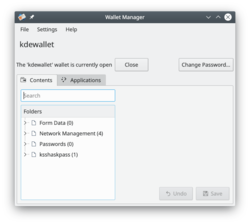KDE Wallet Manager/fr
 |
KWalletManager gère certains de vos mots de passe dans un fichier crypté - mais Kgpg n'utilise pas Kwallet, ni Firefox non plus. |
KWalletManager est un outil facultatif qui peut grandement faciliter votre flux de travail tout en maintenant la sécurité.
- Les « portefeuilles » sont cryptés avec la phrase secrète que vous avez choisie
- Les portefeuilles sont, par défaut, fermés. Votre phrase secrète est requise pour ouvrir un portefeuille
- Les portefeuilles peuvent être configurés pour se fermer lorsqu'ils ne sont pas utilisés
- Vous contrôlez quelles applications peuvent utiliser le portefeuille - tout le reste devra vous demander un mot de passe.
A right-click, context menu on the wallet in kwalletmanager offers maintenance options:
- To create a new wallet
- To open and examine the selected wallet
- To change the passphrase for that wallet
- To disconnect an application currently using that wallet
- To close or delete the wallet
Clicking (or in some versions, double-clicking) on a wallet allows you to examine the contents of a wallet. From here you can remove any entries that you do not wish to be further controlled by the wallet. A further advantage is that it is possible to examine the passwords for individual entries - particularly useful if you have mis-typed a password and stored it. These activities remain secure, since they are only available after you have given the passphrase.
Hints and Tips
How to make an application start using KDE Wallet Manager
Open KDE Wallet Manager, and go to , and there adjust application settings. Useful if you mistakenly told an application not to use KDE Wallet Manager.
Use KDE-wallet with Python in a CLI: CLI.

